中国文化翻译1
传统中国文化八大主题中英翻译
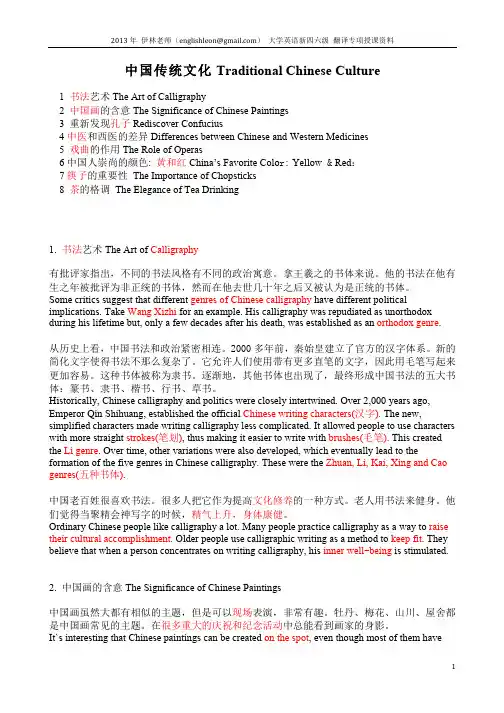
中国传统文化Traditional Chinese Culture1 书法艺术The Art of Calligraphy2 中国画的含意The Significance of Chinese Paintings3 重新发现孔子Rediscover Confucius4中医和西医的差异Differences between Chinese and Western Medicines5 戏曲的作用The Role of Operas6中国人崇尚的颜色:黄和红China’s Favorite Colo r: Yellow & Red:7筷子的重要性The Importance of Chopsticks8 茶的格调The Elegance of Tea Drinking1. 书法艺术The Art of Calligraphy有批评家指出,不同的书法风格有不同的政治寓意。
拿王羲之的书体来说。
他的书法在他有生之年被批评为非正统的书体,然而在他去世几十年之后又被认为是正统的书体。
Some critics suggest that different genres of Chinese calligraphy have different political implications. Take Wang Xizhi for an example. His calligraphy was repudiated as unorthodox during his lifetime but, only a few decades after his death, was established as an orthodox genre.从历史上看,中国书法和政治紧密相连。
2000多年前,秦始皇建立了官方的汉字体系。
新的简化文字使得书法不那么复杂了。
它允许人们使用带有更多直笔的文字,因此用毛笔写起来更加容易。
中国文化汉英翻译材料(1)
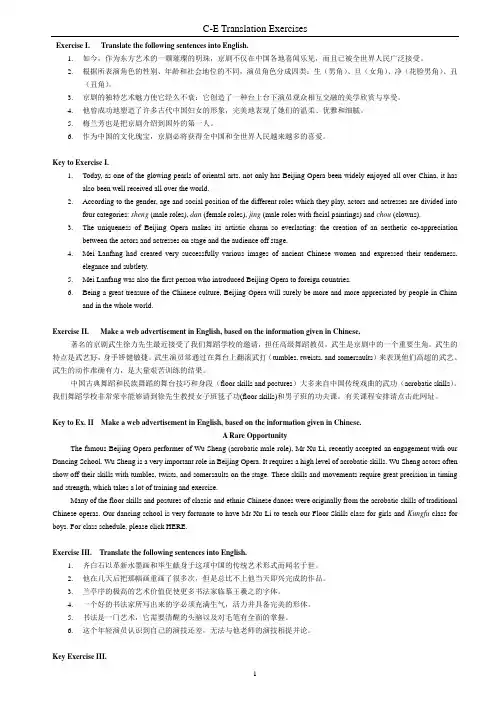
Exercise I. Translate the following sentences into English.1.如今,作为东方艺术的一颗璀璨的明珠,京剧不仅在中国各地喜闻乐见,而且已被全世界人民广泛接受。
2.根据所表演角色的性别、年龄和社会地位的不同,演员角色分成四类:生(男角)、旦(女角)、净(花脸男角)、丑(丑角)。
3.京剧的独特艺术魅力使它经久不衰:它创造了一种台上台下演员观众相互交融的美学欣赏与享受。
4.他曾成功地塑造了许多古代中国妇女的形象,完美地表现了她们的温柔、优雅和细腻。
5.梅兰芳也是把京剧介绍到国外的第一人。
6.作为中国的文化瑰宝,京剧必将获得全中国和全世界人民越来越多的喜爱。
Key to Exercise I.1.Today, as one of the glowing pearls of oriental arts, not only has Beijing Opera been widely enjoyed all over China, it hasalso been well received all over the world.2.According to the gender, age and social position of the different roles which they play, actors and actresses are divided intofour categories: sheng (male roles), dan (female roles), jing (male roles with facial paintings) and chou (clowns).3.The uniqueness of Beijing Opera makes its artistic charm so everlasting: the creation of an aesthetic co-appreciationbetween the actors and actresses on stage and the audience off stage.4.Mei Lanfang had created very successfully various images of ancient Chinese women and expressed their tenderness,elegance and subtlety.5.Mei Lanfang was also the first person who introduced Beijing Opera to foreign countries.6.Being a great treasure of the Chinese culture, Beijing Opera will surely be more and more appreciated by people in Chinaand in the whole world.Exercise II. Make a web advertisement in English, based on the information given in Chinese.著名的京剧武生徐力先生最近接受了我们舞蹈学校的邀请,担任高级舞蹈教员。
中国传统文化英语翻译
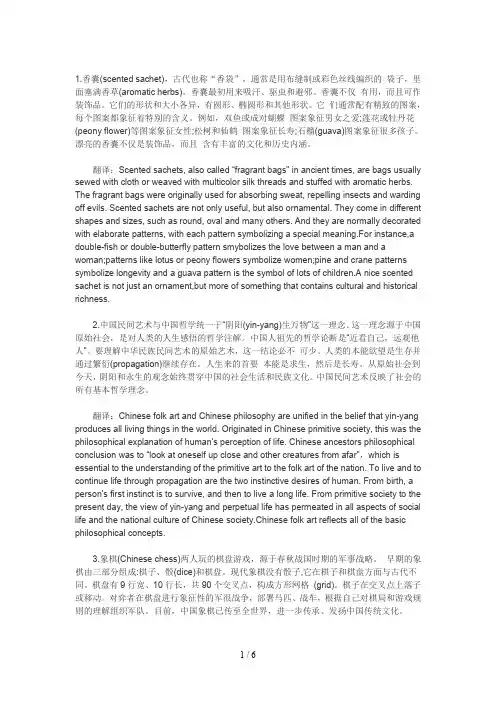
1.香囊(scented sachet),古代也称“香袋”,通常是用布缝制或彩色丝线编织的袋子,里面塞满香草(aromatic herbs)。
香囊最初用来吸汗、驱虫和避邪。
香囊不仅有用,而且可作装饰品。
它们的形状和大小各异,有圆形、椭圆形和其他形状。
它们通常配有精致的图案,每个图案都象征着特别的含义。
例如,双鱼或成对蝴蝶图案象征男女之爱;莲花或牡丹花(peony flower)等图案象征女性;松树和仙鹤图案象征长寿;石榴(guava)图案象征很多孩子。
漂亮的香囊不仅是装饰品,而且含有丰富的文化和历史内涵。
翻译:Scented sachets, also called “fragrant bags” in ancient times, are bags usually sewed with cloth or weaved with multicolor silk threads and stuffed with aromatic herbs. The fragrant bags were originally used for absorbing sweat, repelling insects and warding off evils. Scented sachets are not only useful, but also ornamental. They come in different shapes and sizes, such as round, oval and many others. And they are normally decorated with elaborate patterns, with each pattern symbolizing a special meaning.For instance,a double-fish or double-butterfly pattern smybolizes the love between a man and a woman;patterns like lotus or peony flowers symbolize women;pine and crane patterns symbolize longevity and a guava pattern is the symbol of lots of children.A nice scented sachet is not just an ornament,but more of something that contains cultural and historical richness.2.中国民间艺术与中国哲学统一于“阴阳(yin-yang)生万物”这一理念。
中国文化英语翻译
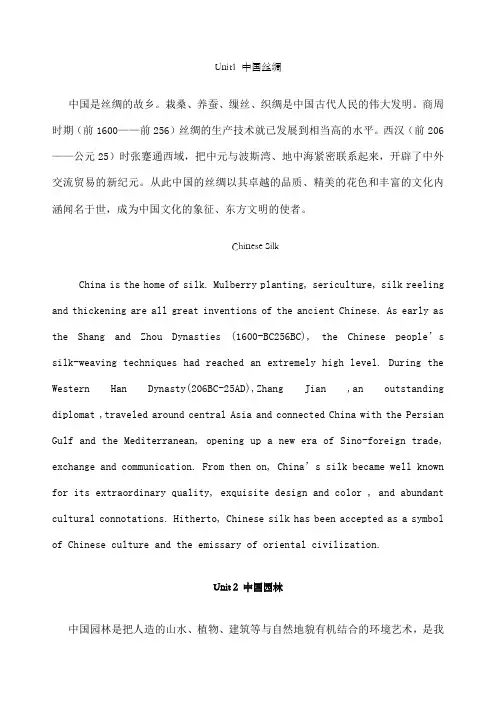
Unit1 中国丝绸中国是丝绸的故乡。
栽桑、养蚕、缫丝、织绸是中国古代人民的伟大发明。
商周时期(前1600——前256)丝绸的生产技术就已发展到相当高的水平。
西汉(前206——公元25)时张蹇通西域,把中元与波斯湾、地中海紧密联系起来,开辟了中外交流贸易的新纪元。
从此中国的丝绸以其卓越的品质、精美的花色和丰富的文化内涵闻名于世,成为中国文化的象征、东方文明的使者。
Chinese SilkChina is the home of silk. Mulberry planting, sericulture, silk reeling and thickening are all great inventions of the ancient Chinese. As early as the Shang and Zhou Dynasties (1600-BC256BC), the Chinese people’s silk-weaving techniques had reached an extremely high level. During the Western Han Dynasty(206BC-25AD),Zhang Jian ,an outstanding diplomat ,traveled around central Asia and connected China with the Persian Gulf and the Mediterranean, opening up a new era of Sino-foreign trade, exchange and communication. From then on, China’s silk became well known for its extraordinary quality, exquisite design and color , and abundant cultural connotations. Hitherto, Chinese silk has been accepted as a symbol of Chinese culture and the emissary of oriental civilization.Unit 2 中国园林中国园林是把人造的山水、植物、建筑等与自然地貌有机结合的环境艺术,是我国古代建筑艺术的珍宝。
中国文化翻译-Chinese Culture
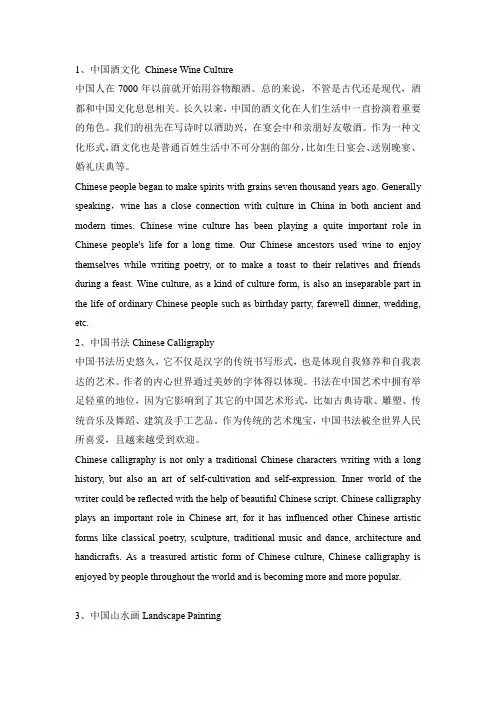
1、中国酒文化Chinese Wine Culture中国人在7000年以前就开始用谷物酿酒。
总的来说,不管是古代还是现代,酒都和中国文化息息相关。
长久以来,中国的酒文化在人们生活中一直扮演着重要的角色。
我们的祖先在写诗时以酒助兴,在宴会中和亲朋好友敬酒。
作为一种文化形式,酒文化也是普通百姓生活中不可分割的部分,比如生日宴会、送别晚宴、婚礼庆典等。
Chinese people began to make spirits with grains seven thousand years ago. Generally speaking,wine has a close connection with culture in China in both ancient and modern times. Chinese wine culture has been playing a quite important role in Chinese people's life for a long time. Our Chinese ancestors used wine to enjoy themselves while writing poetry, or to make a toast to their relatives and friends during a feast. Wine culture, as a kind of culture form, is also an inseparable part in the life of ordinary Chinese people such as birthday party, farewell dinner, wedding, etc.2、中国书法Chinese Calligraphy中国书法历史悠久,它不仅是汉字的传统书写形式,也是体现自我修养和自我表达的艺术。
中国文化翻译(1)
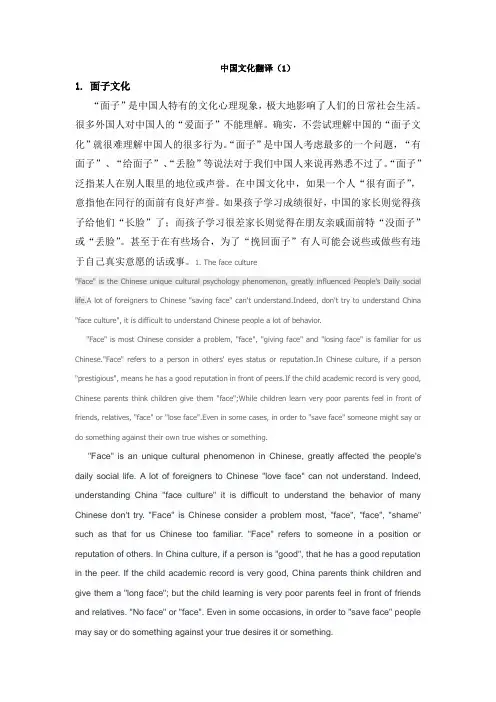
中国文化翻译(1)1. 面子文化“面子”是中国人特有的文化心理现象,极大地影响了人们的日常社会生活。
很多外国人对中国人的“爱面子”不能理解。
确实,不尝试理解中国的“面子文化”就很难理解中国人的很多行为。
“面子”是中国人考虑最多的一个问题,“有面子”、“给面子”、“丢脸”等说法对于我们中国人来说再熟悉不过了。
“面子”泛指某人在别人眼里的地位或声誉。
在中国文化中,如果一个人“很有面子”,意指他在同行的面前有良好声誉。
如果孩子学习成绩很好,中国的家长则觉得孩子给他们“长脸”了;而孩子学习很差家长则觉得在朋友亲戚面前特“没面子”或“丢脸”。
甚至于在有些场合,为了“挽回面子”有人可能会说些或做些有违于自己真实意愿的话或事。
1. The face culture"Face" is the Chinese unique cultural psychology phenomenon, greatly influenced People's Daily social life.A lot of foreigners to Chinese "saving face" can't understand.Indeed, don't try to understand China "face culture", it is difficult to understand Chinese people a lot of behavior."Face" is most Chinese consider a problem, "face", "giving face" and "losing face" is familiar for us Chinese."Face" refers to a person in others' eyes status or reputation.In Chinese culture, if a person "prestigious", means he has a good reputation in front of peers.If the child academic record is very good, Chinese parents think children give them "face";While children learn very poor parents feel in front of friends, relatives, "face" or "lose face".Even in some cases, in order to "save face" someone might say or do something against their own true wishes or something."Face" is an unique cultural phenomenon in Chinese, greatly affected the people's daily social life. A lot of foreigners to Chinese "love face" can not understand. Indeed, understanding China "face culture" it is difficult to understand the behavior of many Chinese don't try. "Face" is Chinese consider a problem most, "face", "face", "shame" such as that for us Chinese too familiar. "Face" refers to someone in a position or reputation of others. In China culture, if a person is "good", that he has a good reputation in the peer. If the child academic record is very good, China parents think children and give them a "long face"; but the child learning is very poor parents feel in front of friends and relatives. "No face" or "face". Even in some occasions, in order to "save face" people may say or do something against your true desires it or something.2.清明清明节是每年的四月四日或者五日。
中国文化翻译
1.中国是舞龙舞狮的起源地。
自问世以来,舞龙舞狮运动一直受到各个民族人民的喜爱,代代相传,长久不衰,并因此形成了灿烂的舞龙舞狮文化。
长期以来,很多青年朋友都以为舞龙,舞狮就是春节,庙会,庆典时的喜庆表演,殊不知它经历了几千年的传承流变,积淀了深厚的历史文化,是祖先留给我们的极其宝贵的文化遗产。
2.The dragon and lion dance originates in China. Since its invention, dragon and lion dance has been the favorite entertainment of various ethnic groups. This enduring art has been handed down from generation to generation, thus forming a splendid dragon and lion dance culture. For a long time, many young people know that the dragon dance and lion dance is the festival performance for the Spring Festival, temple fairs and celebrations, but it has experienced development and changes of several thousand years and accumulated the rich history and culture, therefore it is the precious cultural heritage left by our ancestors.3.丝绸之路是历史上横贯欧亚大陆的贸易交通线,在历史上促进了欧亚非各国和中国的友好往来。
中国文化英语翻译
1、狮舞(Lion Dance)是中国最广为流传的民间舞蹈之一。
狮为百兽之首,在中国传统中,狮子被视为是能带来好运的吉祥物(mascot)。
古人将狮子视作是勇敢和力量的化身,能驱赶邪恶、保护人类。
据记载,狮舞已拥有了2,000多年的历史。
在唐代(theTang Dynasty),狮舞就已经被引入了皇室。
因此,舞狮成为元宵节(the Lantern Festival)和其他节日的习俗,人们以此来祈祷好运、平安和幸福。
The Lion Dance is one of the most widespread folk dances in China.The lion is the king of animals. InChinese tradition, the lion is regarded as a mascot, which can bring good luck.Ancient people regarded the lion as a symbol of braveness and strength, whichcould drive away evil and protect humans. The dance has a recorded history ofmore than 2,000 years. During the Tang Dynasty, the Lion Dance was alreadyintroduced into the royal family of the dynasty. Therefore, performing the liondance at the Lantern Festival and other festive occasions became a custom wherepeople could pray for good luck, safety and happiness.2、中国将进一步发展经济、扩大开放,这对海外企业(enterprises)意味着更多的商机。
中国文化习俗段落翻译
中国文化习俗段落翻译1. 中西方饮食习惯(eating habits)存在极大差异。
不同于西方那种每人一盘食物的饮食习惯,在中国,菜肴是被放在桌上让大家共同分享的。
如果你在中国主人家做客,就要做好有一大桌食物的心理准备。
中国人对于自己的烹饪文化(culture of cuisine)感到非常自豪,而且会尽全力去展示自己的好客(hospitality)。
而且有时候,中国主人会用他们的筷子把食物夹到你的碗里或盘子中。
这是礼貌的体现。
2. 在中国,小孩的满月酒(One-Month-Old Feast)和抓周(One-Year-Old Catch)仪式独具特色。
小孩出生满一个月的那天,孩子的家人一般要招呼亲朋挚友,邀请他们一起来庆祝孩子满月。
小孩儿慢周岁的那天,有抓周到额仪式。
按照中国的传统,父母及他人不给予任何的引导和暗示,任孩子随意挑选,看他先抓什么后抓什么,并以此为依据来预测孩子可能存在的志趣和将从事的职业以及前途。
参考译文1.There are great differences between Chinese and Western eating habits. Unlike the West, where everyone has their own plate of food, in China the dishes are placed on the table and everybody shares. If you are being treated by a Chinese host, be prepared for a table of food. Chinese are very proud of their culture of cuisine and will do their best to show their hospitality. And sometimes the Chinese hosts use their chopsticks to put food in your bowl or plate. This is a sign of politeness.参考译文2: In China, One-Month-Old Feast and One-Year-Old Catch of a baby are of unique Chinese characteristics. On the day when a baby is a month old, the family of the baby will invite their friends and relatives to a ceremony to celebrate the occasion. On the day when a baby is one year old, there is a ceremony of One-Year-Old Catch. According to Chinese traditional custom, nobody will give any instruction or clue to the baby so that it is left free to choose by itself. Watching the baby catch the articles it likes, the family can then make predictions about its potential interest, future career and development.春节贴年画(pasting New Year Print s)的风俗源自于往房子外面的门上贴门神(Door Gods)的传统,随着木质雕刻品(board carvings)的出现,年画包含了更广泛地主题,最出名的就是门神,三大神——福神、薪神、和兽神(three Gods of Blessings, Salary and Longevity),寓意着庄稼丰收、家畜兴旺和庆祝春节。
中国文化常识翻译
中国文化常识Chinese Cultural Common Sense概述中华民族是一个古老的民族,也是一个有深厚文化底蕴的民族。
中国的传统艺术门类繁多、雅俗共赏,从悠扬动人的民间音乐到细腻缠绵的地方戏曲,从疏洁淡雅的水墨画到刚柔并济的书法,无不闪烁着智慧之光,令人赞叹不已。
SummarizeThe Chinese nation is an ancient nation with profound culture deposits. The Chinese traditional culture owns a great varieties; it suits both refined and popular tastes, from the melodious and touching folk music to the exquisite and lingering local operas, from the simple and elegant wash painting to the calligraphies with both hardness and softness, all of them are sparkling with wisdom, which makes people deeply admired.舞狮舞狮大约起源于南北朝时期,到了唐朝,狮子舞已发展为上百人集体表演的大型歌舞。
舞狮在中国是一项传统体育项目,也是一种传统文化艺术,从北方到南方,从城市到乡村,逢年过节及庆典盛事,都可以看到欢快的舞狮。
民间认为舞狮可以很好地把百姓的欢喜心情表达出来,也最能烘托热闹气氛。
舞狮尤以广东地区一带最为盛行。
用来舞动的狮子外形威武,动作刚劲,神态多变,广东人称它为“醒狮”。
中国百姓对狮子有图腾般的崇敬感,狮子在民间有很多传说,其位置仅次于龙,因此舞狮也就带有了不少神秘色彩。
人们相信狮子是吉祥瑞兽,而舞狮能够带来好运,所以每逢节日和喜庆活动,都会舞狮助兴,祈求吉利和如意。
- 1、下载文档前请自行甄别文档内容的完整性,平台不提供额外的编辑、内容补充、找答案等附加服务。
- 2、"仅部分预览"的文档,不可在线预览部分如存在完整性等问题,可反馈申请退款(可完整预览的文档不适用该条件!)。
- 3、如文档侵犯您的权益,请联系客服反馈,我们会尽快为您处理(人工客服工作时间:9:00-18:30)。
京剧是综合性表演艺术,集唱(歌唱)、念(念 白)、做(表演)、打(武)、舞(舞蹈)为一体, 通过程式化的表演,叙述故事,刻画人物。
Beijing Opera is a blend of/a comprehensive/an integrated performing arts, involving/including singing, speaking, performing, fighting and dancing. Beijing Opera narrates the plot and portrays/depicts characters through stylized/standardized acting.
京剧被誉为“东方歌剧”, 是地道的中国国粹, 起源于中国多种古老的地方戏剧。 Praised/Honored as “Oriental Opera”, Beijing Opera is a authentic/genuine national quintessence of China. It originated/derived from various kinds of ancient local operas.
到了19世纪末,京剧形成并成为中国最大的戏曲 剧种。 At the end of the 19th Century, Beijing Opera evolved and took shape, becoming the greatest/most popular/most widespread kind of opera in China.
京剧中的角色主要分生(男性)、旦(女性)、净 (花脸男性)、丑(男性女性皆有)四大行当。 The main/major types of roles in Beijing Opera are sheng (male), dan (female), jing (wn, male or female).
京剧被誉为“东方歌剧”, 是地道的中国国粹 (quintessence),起源于中国多种古老的地方戏剧。 到了19世纪末,京剧形成并成为中国最大的戏曲 剧种。京剧是综合性表演艺术,集唱(歌唱)、念 (念白)、做(表演)、打(武)、舞(舞蹈)为 一体,通过程式化的表演,叙述故事,刻画人物。 京剧中的角色主要分生(男性)、旦(女性)、净 (花脸男性)、丑(男性女性皆有)四大行当。
